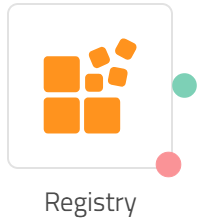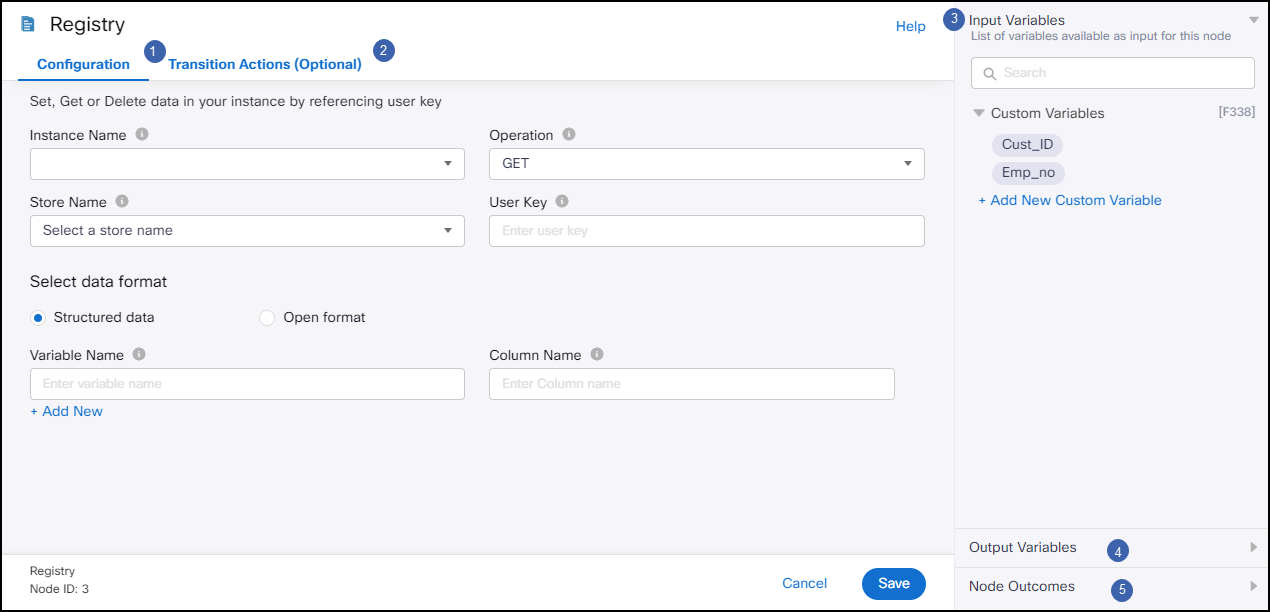Registry Node [Deprecated]
Understand what a Registry node is and how to configure it
Deprecation Alert
Please note that this node is being deprecated and will not be offered in the future. This decision does not impact the existing tenants that have access to and are using this node.
The Registry node enables you to set, get or delete data from your instance by referencing user key. You can set or get the data either from structured data or open format.
As part of these operations, you need to specify the store name (where the values are stored) along with the user key.
When you double-click this node, the Registry screen appears with two tabs: Configuration and Transition Actions. The Configuration tab enables you to configure the settings to get, delete, and set operations whereas the Transitions tab provides configuring the node on-enter/on-leave operations.
Here is the node image:

Screenshot of Registry Node.
Interface Elements

Screenshot of Registry Node Configuration Page.
Here is the description for the interface elements:
| S. No | Element | Description |
|---|---|---|
| 1 | Configuration tab | Use this tab to configure the registry operations including get, delete, and set. Here is the description for the fields: Instance Name Use this drop-down box to specify the application from which you wish to get, delete, or set the data. Operation Use this drop-down box to select get, delete, or set. Store Name Use this drop-down box to select the store where the values are stored. User Key Use this field to specify the user key corresponding to the selected store. Structured Data and Open Format These two options appear when the Get and Set options are selected. |
| 2 | Transition Actions tab | Use this tab to configure node on-enter/on-leave operations. Here is the description for the fields: Add action link - Click it to view the Transition action fields. |
| 3 | Input Variable | Click this collapsible panel to view the list of all the available flow variables. You can search for a variable using the Search field. You can also add a variable to the flow variables list by clicking the Add new flow variable link at the bottom of the list. |
| 4 | Output Variables | Click this collapsible panel to view the output variables. The data generated through the Get operation is displayed as variable here. |
| 5 | Node Outcomes | Click this collapsible panel to view the list of possible node outcomes. You can also customize the node labels by clicking the Edit icon. |
Configuring Registry Operations
You can get, delete, or set data in your instance by referencing the user key.
Here are the steps:
Getting Data from a Store
- Double click the Registry node.
The Registry screen appears. - On the Registry screen:
- From the Instance drop-down box, select the instance from which you wish to get the data.
- From the Operation drop-down box, select Get.
- From the Store drop-down box, select the store where the variables are stored.
- Specify the User Key corresponding to the selected store.
- In the Select Data Format area, select Structured Data or Open Format.
- If the selected option is Structured Data, then specify the Variable Name (in which the data is stored) and Column Name.
- Click the Save button at the bottom.
The data is fetched from the selected store and is displayed in the Output Variables collapsible panel.
Deleting a Store
- Double click the Registry node.
The Registry screen appears. - On the Registry screen:
- From the Instance drop-down box, select the instance from which you wish to delete the data.
- From the Operation drop-down box, select Delete.
- From the Store drop-down box, select the store where the variables are stored.
- Specify the User Key corresponding to the selected store.
- Click the Save button at the bottom.
The selected store is deleted.
Setting Data in a Store
- Double click the Registry node.
The Registry screen appears. - On the Registry screen:
- From the Instance drop-down box, select the instance from which you wish to get the data.
- From the Operation drop-down box, select Set.
- From the Store drop-down box, select the store where the variables are stored.
- Specify the User Key corresponding to the selected store.
- In the Select Data Format area, select Structured Data or Open Format.
- If the selected option is Structured Data
- Specify the Column Name and Column Value. which is to be set.
If the selected option is 'Structured Data'
- Specify the Column Name and Column Value. from which the data is to be set.
Note: Click Add New if you need more columns.
If the selected option is 'Open Format'
- In the Data Value box, specify the data, which is to be set.
Note: You can specify any data in any format. It gets stored in the selected store in the same format. - Click the Save button at the bottom.
The data is set in the store.
Configuring Transitions
As part of configuring transition actions, you can configure on-enter/on-leave operations. However, configuring these are optional.
Here are the steps:
- On the Registry screen, click the Transition Actions tab.
- On the Transition Actions tab, click Add Action.
The Transition Actions area appears. - On the Transition Actions area:
- From the Time drop-down box, select On-enter or On-leave. For example, On-enter.
- From the Acton drop-down box, select an action choosing from the pre-built options.
Tip
To delete an event, click the delete button corresponding to that event. See the image below.

Delete Button
- Finally, click the Save button at the bottom.
The transition actions are configured.
Updated 9 months ago
